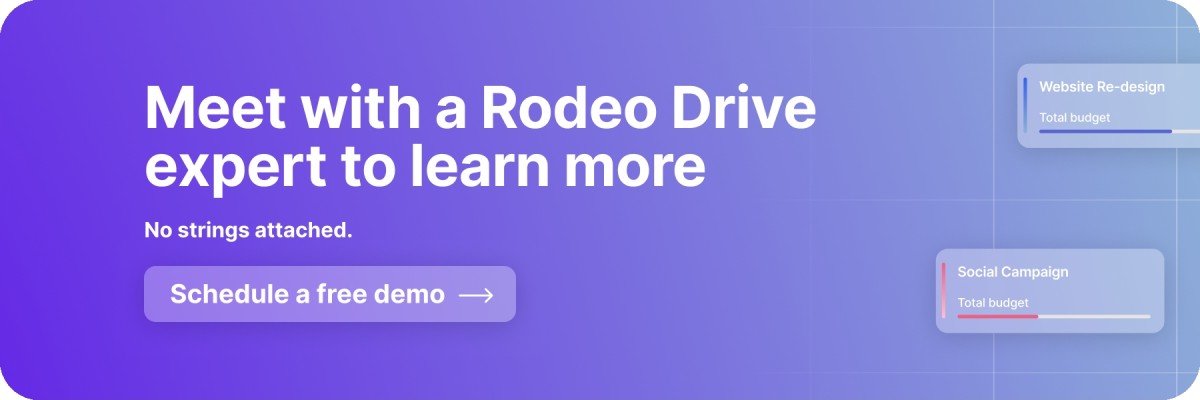Your Ultimate Guide to Setting Successful Project Goals
Successful projects depend on well-defined goals to chart their course. Realistic goals keep project teams focused, stakeholders informed, and resources efficiently allocated. When setting goals, you’ll want to find a careful balance between ambition and feasibility — you want goals that push your organization forward, but that are achievable as well.
This guide aims to equip project leads with the skills to set achievable, yet challenging project goals. We’ll cover what makes a project goal effective, the role of a project manager in the goal-setting process, and tips for setting goals that propel projects to success.
By the end of this guide, you’ll understand the foundational ideas behind effective goal-setting. You’ll also have actionable strategies to apply stronger goal-setting in your projects.
What are project goals?

Project goals, not to be confused with objectives, provide the direction and sense of purpose for the overall project. Unlike everyday to-do lists, project goals explain the bigger picture — what success looks like at the end of the project’s lifecycle.
In practice, this means creating a statement of the project’s desired outcome. Looking at a marketing campaign, for example, this statement may look like “Increase the generation of marketing-qualified leads by 30% in five months.”
Communicating this statement gives people working on the project a clear understanding of what they’re trying to achieve. From there, you can discuss logical milestones and allocate resources in a way that will help you reach that goal.
The purpose of goal-setting is to structure effort, keeping everyone focused on pursuing the most meaningful results for your organization.
The difference between project goals and objectives

This leads us into setting objectives. While they’re similar in everyday use, in the context of project management, project goals and objectives are not the same thing.
Goals are the big, overarching outcomes you want to achieve. They’re aspirational and somewhat conceptual. They provide a general direction but don’t explain how the team will get there.
Objectives, in comparison, are the specific, tangible steps you’ll take to reach your project goals. They are measurable and actionable, providing a roadmap of what you’ll need to do specifically to get to your goals.
Consider a project aimed at enhancing a website's user experience. A goal might be to "Improve user satisfaction by improving the experience on our website.” It’s a good goal, but it’s not something that charts a narrow course of action. A team can interpret and go about making the experience of a website better in countless ways.
This is where objectives are useful. They explain the how of a goal. An objective to support this goal could be "Reduce the average page load time by 50% within three months." This is a more measurable outcome with steps that can easily be broken down into tasks a team can perform.
And the great thing about objectives is you can stack multiple to reach your goal. Using our previous example, you can set multiple objectives which together, will contribute to the big picture goal of improving customer satisfaction with the website.
A guide to the main project goal frameworks
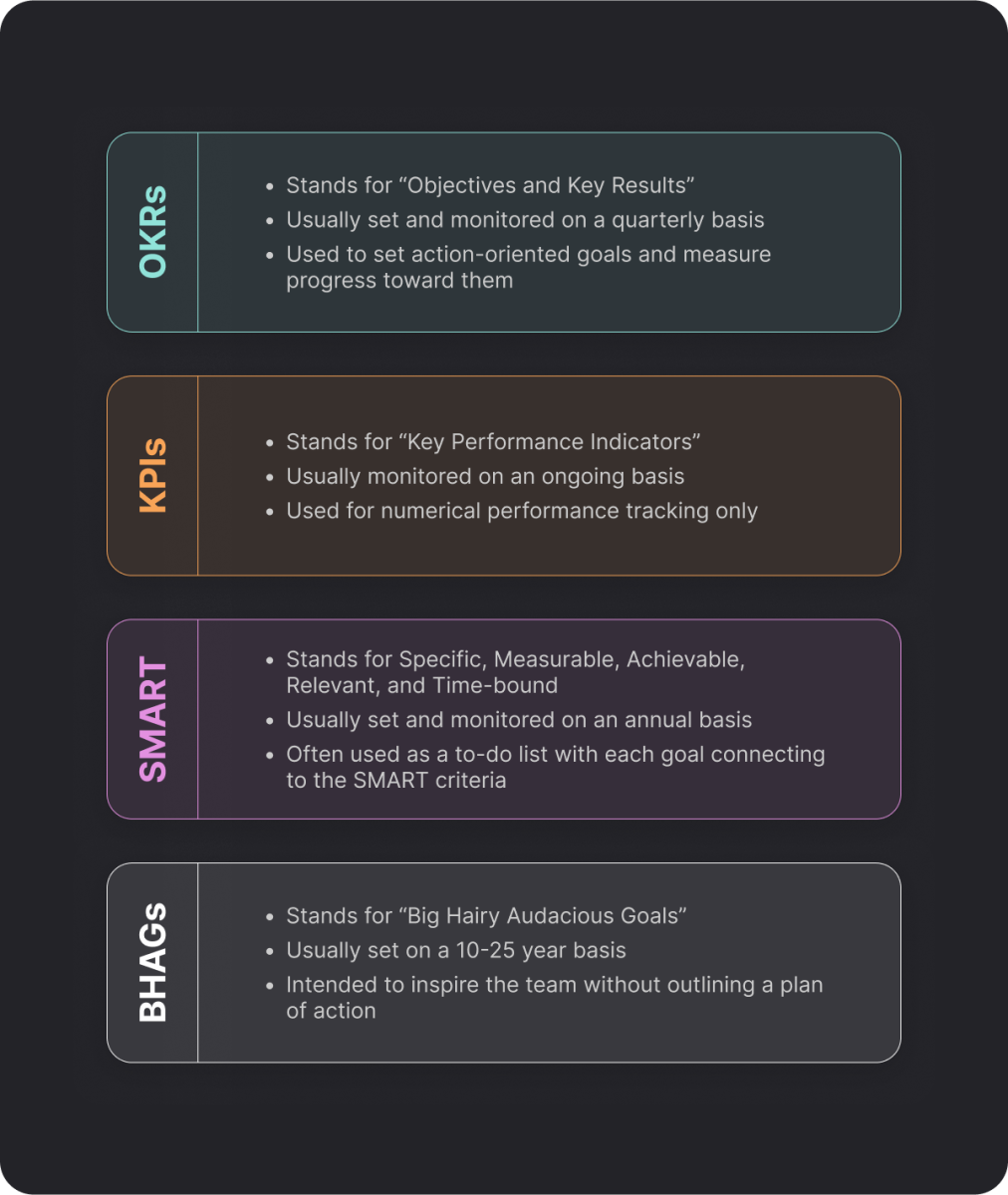
Shifting our focus back to goals, there are many frameworks you can use to structure your project management goals. You might want to use a framework because they specify how goals should be set, how they will be accomplished, and how they will be tracked.
Essentially, they cover everything necessary for a goal to be considered ‘good.’ Plus, they keep goal-setting standards consistent throughout your organization.
The following goal-setting frameworks are some of the most popular.
SMART goals
SMART stands for specific, measurable, achievable, relevant, and time-bound.
The SMART framework is focused on creating goals that are clear and measurable. It’s an easy framework to implement, making it a good choice for any team that’s making its first foray into measuring results.
A SMART goal for an online retailer might be, "Increase the online store's sales by 20% in the next quarter by optimizing product listings and launching a targeted ad campaign." This goal is specific (increase sales), measurable (by 20%), achievable (optimizing product listings and launching a targeted ad campaign), relevant (to the online retailer's success), and time-bound (in the next quarter).
Objectives and key results (OKRs)
OKRs combine ambitious goals with measurable results to challenge teams. The objective component is about setting a difficult qualitative goal, like "Become the leading content provider in our niche," while the key results portion quantifies that goal, such as "Achieve a monthly traffic of over one million visitors," or "Increase subscriber count by 30%."
With OKRs, goals can be aspirational and very long-term, requiring years to achieve. Using measurable key results, however, breaks down those goals into medium-term goals that can be pursued with concrete objectives.
Key performance indicators (KPIs)
KPIs, or key performance indicators, are metrics that evaluate how successful a team is in meeting objectives over time. In goal-setting, they can be used as checkpoints along the path of a larger goal. KPIs are especially useful for making qualitative or continuous goals measurable and specific.
For example, if your goal is to maintain a high level of customer service, a KPI could be "Achieve a customer satisfaction score of 90% in surveys." Initially, this goal is both qualitative and continuous, however, by setting KPIs it becomes something specific that can be measured.
Big hairy audacious goals (BHAGs)
A BHAG is a long-term, visionary goal that is meant to inspire and motivate a team. It's so ambitious that it seems unattainable, yet it aligns with the core values and long-term vision of your organization.
An example might be "Become the most recommended brand in our industry within a decade." BHAGs challenge teams to think creatively and push beyond conventional limits.
Also read: Stretch Goals: Definitions, Pros, Cons, and Examples
Why bother setting project goals?
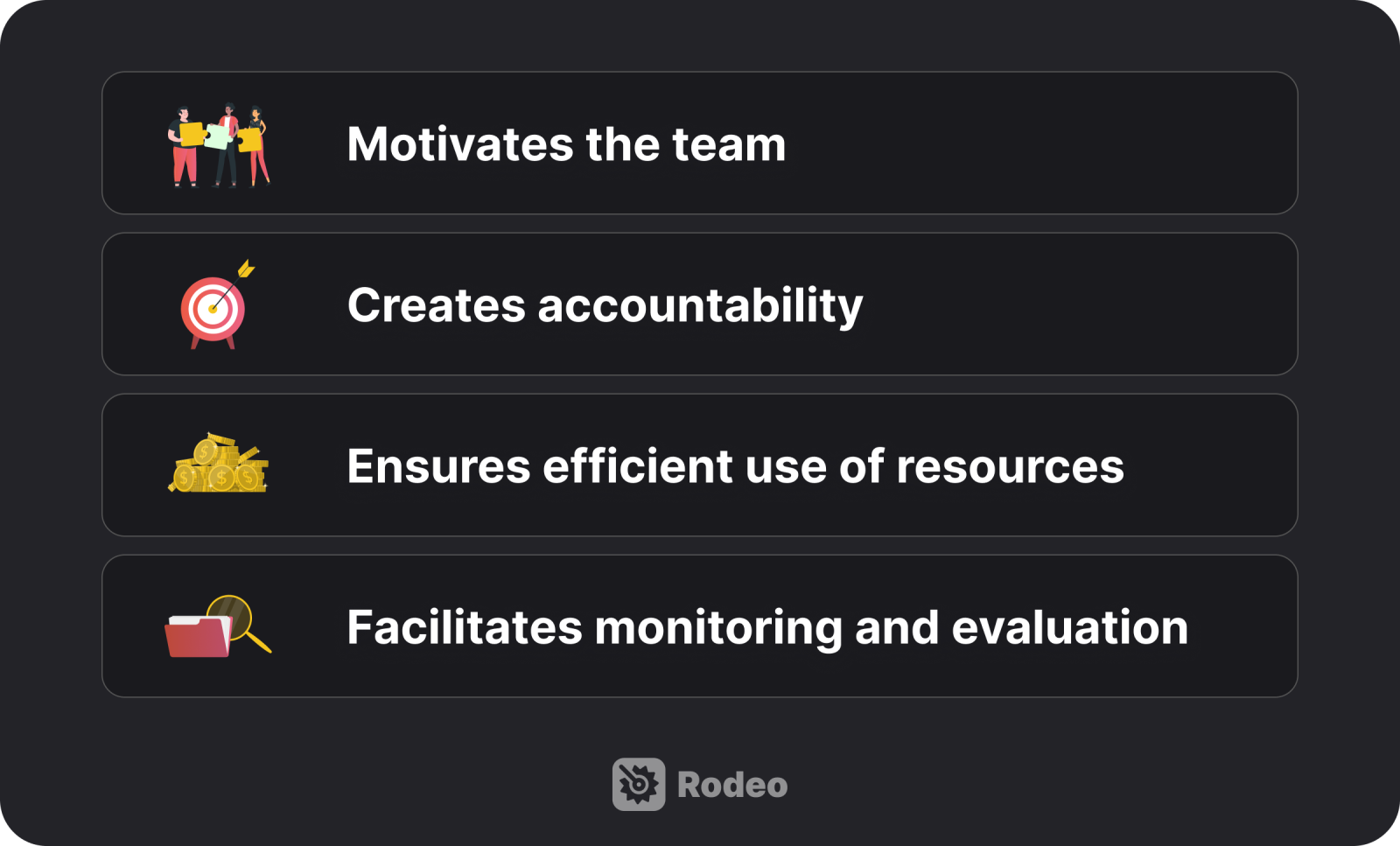
Projects are rarely a one-day affair. If you’re trying to achieve results over a longer timeline, project goals are important for keeping focus and getting what you want out of an endeavor. Here's why goal-setting is indispensable in project management:
- Motivates the team: Clearly defined goals give your team something concrete to strive for. They transform abstract ideas into attainable targets, boosting motivation, morale, and engagement.
- Creates accountability: When project goals are set, responsibilities become clearer. Team members understand their roles and contributions towards achieving these goals, fostering a culture of accountability.
- Ensures efficient use of resources: With clear goals, you can allocate resources more effectively, avoiding waste and ensuring that every effort moves you closer to your project's success.
- Facilitates monitoring and evaluation: Goals provide benchmarks for project progress. They enable you to measure how well the project is advancing and when to adjust strategies for better outcomes.
Also read: How to Visualize Project Progress
What to avoid when setting project goals
While setting goals is crucial, how you set them can determine your project's fate. Here are common pitfalls to avoid:
- Overly ambitious goals: While ambition is valuable, unrealistic goals can demoralize your team. Aim for challenging yet achievable targets.
- Vague goals: Specificity is key. Vague goals lack actionable direction, making it difficult to gauge progress or success.
- Ignoring stakeholder input: Stakeholders often have insights that can refine your goals. Overlooking their input can lead to misaligned priorities and project objectives.
- Neglecting feasibility analysis: Always assess the resources, time, and context. Goals set without considering these factors are more likely to fail.
5 tips for setting realistic project goals
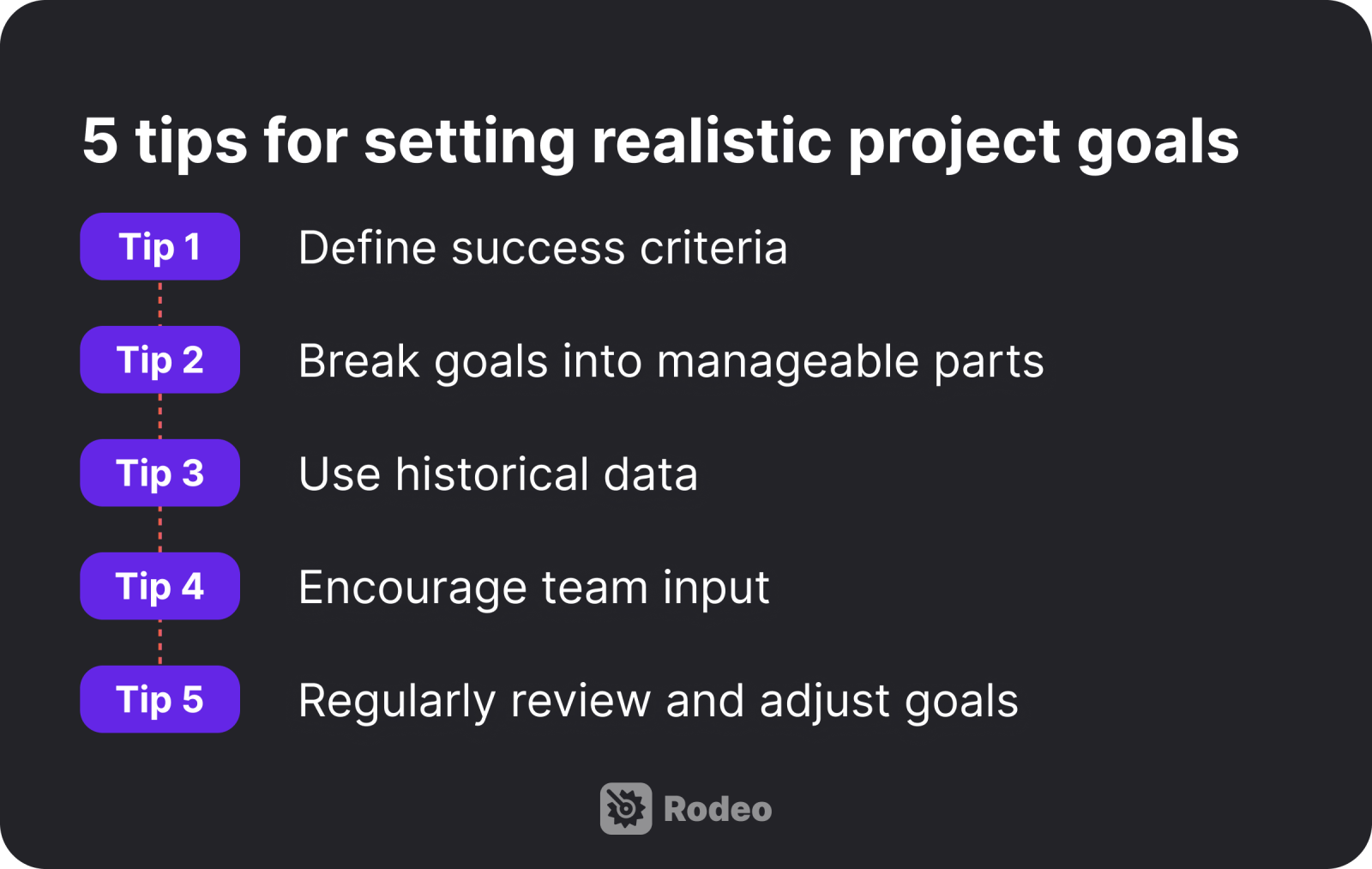
Now that you know what to avoid when setting goals, it’s time to get into some best practices for goal setting. Here are five tips to help you out.
Tip 1: Define success criteria
Start by clearly defining what success looks like for your project. Your project success criteria should address both qualitative and quantitative benchmarks that align with your goals.
Tip 2: Break goals into manageable parts
Goals are large, and for that reason, they can be overwhelming. Break them down into smaller, more manageable project objectives that can be tackled step by step.
Tip 3: Use historical data
Look back at past projects for insights into what’s achievable. Historical performance can guide your goal-setting process, helping you set realistic targets based on actual outcomes. Reporting features in project management software can automate the collection and storage of this information.
Tip 4: Encourage team input
Your team's insights are invaluable. Encourage dialogue about goal feasibility and what project objectives make the most sense. Draw on their experience and expertise to set a realistic course toward your goals.
Tip 5: Regularly review and adjust goals
Flexibility is key. Regularly review your goals against progress and prepare to make adjustments as needed. This keeps your project agile and responsive to unforeseen risks.
The role of a project manager in goal setting

As a project manager, your role is to connect the goal-setting process. This means when your organization sets goals, you’re responsible for bringing together the vision of stakeholders with the expertise of team members, all while considering the realities of resource constraints.
The aim is to create a shared consensus on the project’s direction among all direct and indirect participants.
Consider a retail company, where the executive team has set an organizational goal of increasing repeat customer rates and enhancing brand loyalty. A project manager tasked with achieving this goal may need to align multiple cross-functional teams with these broader objectives.
This could mean defining goals — from improving the in-store shopping experience, to streamlining the returns process, to enhancing the perception of the brand — and distributing them to relevant teams. The respective team leads can then set objectives that align with reaching their assigned goals.
Finally, project managers are responsible for monitoring progress toward goals and making adjustments as necessary. Project management software can make it easier to track progress and revisit goals.
Also read: A Comprehensive Guide on How to Become a Project Manager
How to set realistic project goals
While we’ve covered some goal-setting frameworks like BHAG that encourage ambitious, unattainable goals, in the context of time-limited projects, it's generally desirable to have grounded goals that are achievable.
Setting realistic goals starts with understanding your project scope and creating a clear vision for success.
Assess the feasibility of your goals
Start with a thorough feasibility assessment or proof of concept to see how your goals stack up with reality.
Suppose you're leading a project to improve the energy efficiency of a manufacturing process. A feasibility assessment might involve analyzing current energy usage, evaluating the efficiency of existing equipment, and researching available technologies. This process helps you set goals that are ambitious but based on a realistic understanding of what can be achieved.
Benchmarking against similar projects can provide valuable insights into what is achievable. For example, if previous projects have achieved a 10% reduction in energy usage with certain technologies, setting a goal for a 25% reduction might be realistic with the adoption of newer, more efficient technologies or processes. However, aiming for a 50% reduction without a clear basis for such an improvement would likely be unrealistic.
Consult team members and domain experts
.png)
Involving your team in the goal-setting process is critical. They can offer insights into potential challenges and opportunities you might not have considered.
For instance, in a project aimed at launching a new product, your team might highlight critical factors such as production capabilities, supply chain logistics, and market demand that could impact your goals.
Team members tend to have a better on-the-ground understanding of what is actually achievable. So, taking this collaborative approach makes sure your goals factor in the capacity of your organization. It also gives team members a sense of ownership over attaining those goals.
Measure resource availability
Considering resource availability is also vital. Realistic goals consider the time, budget, skills, and materials available for the project.
If your goal involves developing a new technology, you need to consider whether you have the necessary expertise in-house or if additional training or hiring is needed, and whether such steps are feasible within your project's constraints.
Set up contingency plans
Finally, you can make goals more realistic by acknowledging potential risks and creating plans to mitigate them. This might involve setting aside money for a contingency budget, planning for extra time to deal with delays, or having backup suppliers in case of supply chain disruptions.
In sum, setting realistic goals requires a pragmatic assessment of your organization’s capabilities and constraints. Considering deadlines, resources, risks, and team capacity will result in goals that are well-rounded and more viable.
Keep track of your team’s progress toward project goals with Rodeo Drive
Clear goals and objectives make action possible. That’s where Rodeo Drive comes in. It’s a project management solution that helps you take project goals and chart them into real activities and phases.
The platform has features to build and monitor budgets, assign project activities, track time, send estimates, and access progress reports. Additionally, the financial features in Rodeo Drive integrate with QuickBooks, allowing for a seamless workflow between your project and accounting teams.
Here’s how its planning and reporting features can facilitate your goals:
Plan project timelines and activities
Rodeo Drive’s planner makes assigning activities simple. It operates on a timeline view, which allows you to see what’s currently on each team member’s plate across all ongoing projects. From there, you can assign them additional project activities based on their availability.
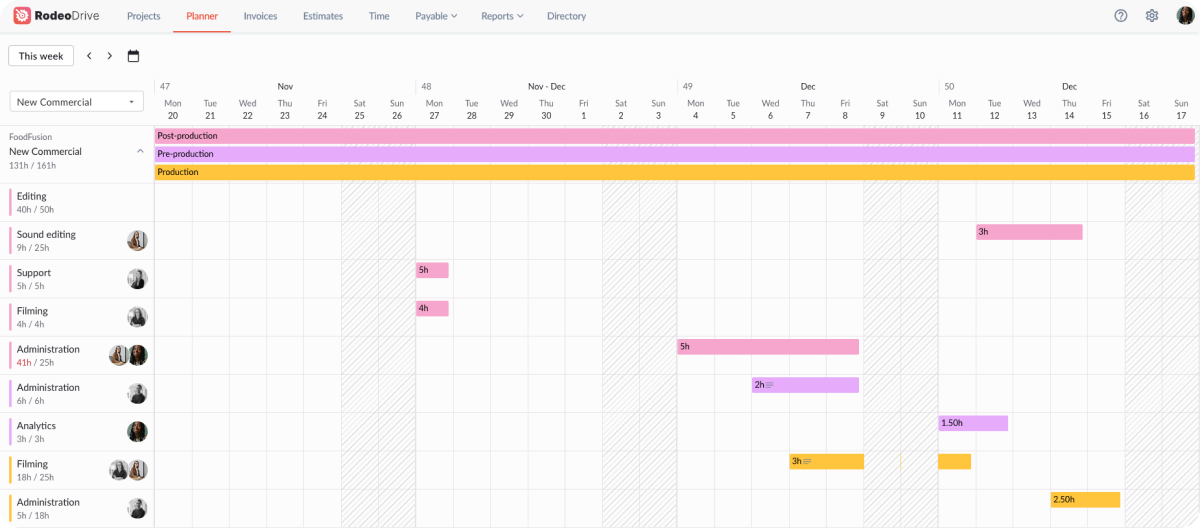
Oversee timelines and assign project activities using Rodeo Drive’s planner
Plus, with the planner’s people view, it’s even easier to assess team workloads and prevent burnout. This feature shows the number of hours each team member has scheduled toward project activities, giving you visibility into their availability or whether their time is already overall allocated.
This simplifies capacity management, enabling you to strike the golden balance between overcommitting and underutilizing team members. After all, team burnout will hinder your team’s ability to meet its goals.
Track progress with reports
Rodeo Drive automatically compiles time and financial data into a comprehensive suite of reports. The reports provide an easy, at-a-glance understanding of your project expenses, the costs of your billable time, the amount you’ve invoiced, and your gross margins.
These reports keep you updated on the progress and financial status of your projects, as well as how well team members are using their time. Using the reports, you can understand the status of your projects in real time and make adjustments to keep them on the right path.
.png)
Access a suite of reports on time, costs, and project margins
Translate your project goals into action by using Rodeo Drive for free. See firsthand how it can bring clarity to your projects.






